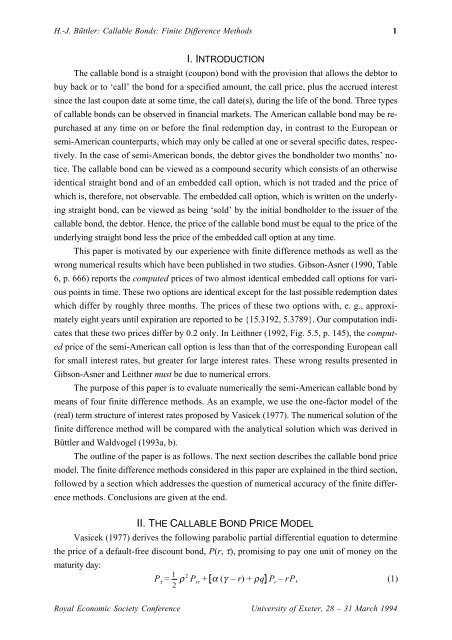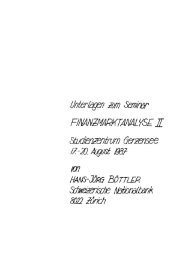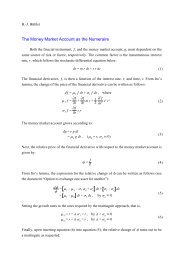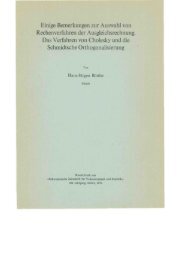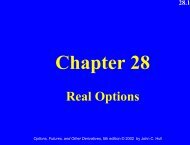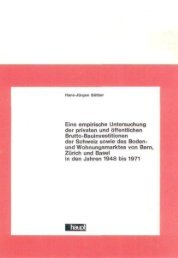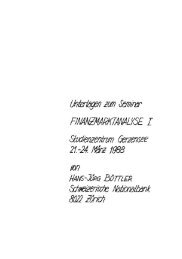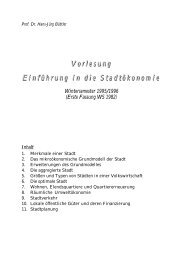Callable Bond/EJ/e
Callable Bond/EJ/e
Callable Bond/EJ/e
Create successful ePaper yourself
Turn your PDF publications into a flip-book with our unique Google optimized e-Paper software.
H.-J. Büttler: <strong>Callable</strong> <strong>Bond</strong>s: Finite Difference Methods 1<br />
I. INTRODUCTION<br />
The callable bond is a straight (coupon) bond with the provision that allows the debtor to<br />
buy back or to ‘call’ the bond for a specified amount, the call price, plus the accrued interest<br />
since the last coupon date at some time, the call date(s), during the life of the bond. Three types<br />
of callable bonds can be observed in financial markets. The American callable bond may be repurchased<br />
at any time on or before the final redemption day, in contrast to the European or<br />
semi-American counterparts, which may only be called at one or several specific dates, respectively.<br />
In the case of semi-American bonds, the debtor gives the bondholder two months’ notice.<br />
The callable bond can be viewed as a compound security which consists of an otherwise<br />
identical straight bond and of an embedded call option, which is not traded and the price of<br />
which is, therefore, not observable. The embedded call option, which is written on the underlying<br />
straight bond, can be viewed as being ‘sold’ by the initial bondholder to the issuer of the<br />
callable bond, the debtor. Hence, the price of the callable bond must be equal to the price of the<br />
underlying straight bond less the price of the embedded call option at any time.<br />
This paper is motivated by our experience with finite difference methods as well as the<br />
wrong numerical results which have been published in two studies. Gibson-Asner (1990, Table<br />
6, p. 666) reports the computed prices of two almost identical embedded call options for various<br />
points in time. These two options are identical except for the last possible redemption dates<br />
which differ by roughly three months. The prices of these two options with, e. g., approximately<br />
eight years until expiration are reported to be {15.3192, 5.3789}. Our computation indicates<br />
that these two prices differ by 0.2 only. In Leithner (1992, Fig. 5.5, p. 145), the computed<br />
price of the semi-American call option is less than that of the corresponding European call<br />
for small interest rates, but greater for large interest rates. These wrong results presented in<br />
Gibson-Asner and Leithner must be due to numerical errors.<br />
The purpose of this paper is to evaluate numerically the semi-American callable bond by<br />
means of four finite difference methods. As an example, we use the one-factor model of the<br />
(real) term structure of interest rates proposed by Vasicek (1977). The numerical solution of the<br />
finite difference method will be compared with the analytical solution which was derived in<br />
Büttler and Waldvogel (1993a, b).<br />
The outline of the paper is as follows. The next section describes the callable bond price<br />
model. The finite difference methods considered in this paper are explained in the third section,<br />
followed by a section which addresses the question of numerical accuracy of the finite difference<br />
methods. Conclusions are given at the end.<br />
II. THE CALLABLE BOND PRICE MODEL<br />
Vasicek (1977) derives the following parabolic partial differential equation to determine<br />
the price of a default-free discount bond, P(r, τ), promising to pay one unit of money on the<br />
maturity day:<br />
P τ<br />
= 1<br />
2 ρ 2 P rr<br />
+ α (γ – r) + ρq P r<br />
– rP, (1)<br />
Royal Economic Society Conference University of Exeter, 28 – 31 March 1994


